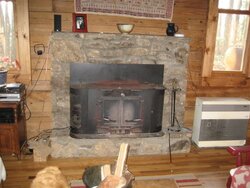Newbie here. Just bought a 1600 sq foot log cabin in the NC mtns. There is a stone fireplace/chimney with an old (approx 20 years) wood burning insert equipped with a loud fan that must be manually turned on and off. It does a decent job heating the house but we would like to replace it with a new, more efficient set up. The stone chimney is on an outer wall of the house and is in the main living area with vaulted ceiling. Open floor plan to downstairs kitchen and upstairs bedrooms.
The stone hearth depth is only 12". The front opening width is 37.5", the lintel height is 28", the fireplace depth is 24".
My question is whether I should purchase another insert or go with a free standing stove. For both options, I plan to install a 6" flex SS liner up the chimney.
I am leaning towards the free standing stove as I don't want to rely on a blower as much and I feel I would get more heat from a free standing stove.
Based on my hearth depth, the stove would likely sit half in and half out of the chimney.
So far, I have looked at the following stoves.....Jotul F500 Oslo, and Regency wood stoves and classic hearth heater
and the following inserts...Jotul Kennebec, Avalon, Regency, and 33Elite.
Any thoughts, suggestions, or experiences would be much appreciated. My local dealer has Jotuls at 10% off for the next two weeks.
The stone hearth depth is only 12". The front opening width is 37.5", the lintel height is 28", the fireplace depth is 24".
My question is whether I should purchase another insert or go with a free standing stove. For both options, I plan to install a 6" flex SS liner up the chimney.
I am leaning towards the free standing stove as I don't want to rely on a blower as much and I feel I would get more heat from a free standing stove.
Based on my hearth depth, the stove would likely sit half in and half out of the chimney.
So far, I have looked at the following stoves.....Jotul F500 Oslo, and Regency wood stoves and classic hearth heater
and the following inserts...Jotul Kennebec, Avalon, Regency, and 33Elite.
Any thoughts, suggestions, or experiences would be much appreciated. My local dealer has Jotuls at 10% off for the next two weeks.


